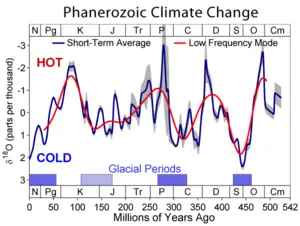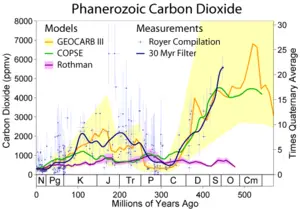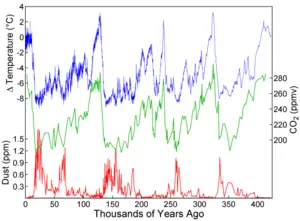Paleoclimatology
Paleoclimatology literally means the study of (-ology) of past (paleo-) climates. The study of past climates ranges on time scales on the order of decades to millions of years. Scientists employ a number of tools and concepts to study past climate and climate change. These tools include sediment cores, ocean cores, ice cores, geologic features and stratigraphy, cave deposits (speleothems), and tree rings (dendrochronology), and fossil coral. Each of these different tools contains useful proxies, which provide clues about different aspects of past climates. From sediment cores from the ocean bottom and lake bottom, oxygen isotopes preserved in the skeletons of dead organisms (foraminifera) are used, gas bubbles trapped in ice cores can provide information on past atmospheric conditions, whereas dust and volcanic ash content can provide information on atmospheric circulation patterns, climate, and volcanic activity. Terrestrial sediment records from peatlands and lakes are studied for pollen and plant macrofossils content and dated using radiocarbon methodology. Tree rings are analyzed for indications of stress related to drought or tectonic activity, and fossil corals are analyzed for their isotopic changes.
A number of factors influence earth's climate and climate change through time, including changes in the earth's orbit and position with respect to the sun, continental drift, mountain building, and volcanic activity. More recently, the burning of fossil fuels has been implicated in anthropogenic climate change.
Techniques of paleoclimatology
Paleoclimatology relies on a number of geologic concepts, including the idea that sediment layers are deposited chronologically, with the oldest layers occurring at the bottom, and uniformitarianism, that the present is the key to the past. Dating techniques support the idea that layers are deposited chronologically.
Ice cores
Currently the only ice sheets are found on Antarctica and Greenland. As snow falls on these ice sheets it compacts with time, forming distinct depositional layers with each consecutive season of snow accumulation. These layers contain tiny bubbles of gas that hold information about atmospheric conditions at the time the bubbles were last in contact with the surface. The Greenland GRIP and GISP2 ice cores and Antarctica Vostok record have been correlated to each other up to 100,000 years (Bender et al. 2002), but one Antarctic record goes back 740,000 years (Augustin et al 2004). Methane, carbon dioxide, and other atmospheric properties are extracted from the gas bubbles and analyzed and dated by counting stratigraphic layers. Volcanic ash layers deposited in the ice cores can be cross correlated to other records based on composition and thickness as a means of constraining the dates. Dust in ice cores provide additional information about climate. During glacial periods, it is thought that climate was drier and windier because of abundant dust layers during these periods. Inside of these layers scientists have found pollen, allowing them to estimate the total amount of plant growth of that year by the pollen count. The thickness of the layer can help to determine the amount of rainfall that year.
Ocean Cores
Various proxies in ocean cores provide information about climate cooling or warming as well as changes in ocean circulation patterns. Microscopic organisms called foraminifera form calcareous shells which then fall to the ocean floor when they die. The isotopic composition of these shells reflects the isotopic composition at that time. 13C/12C ratios are used as paleo-ocean circulation change tracers and oxygen isotope changes reflect sea surface temperature changes.
Three isotopes of oxygen exist, O-16, O-17, and O-18. O-18 is two neutrons heavier than O-16, meaning that it takes more energy for it to be incorporated into molecules than O-16. A warmer water temperature means that the molecules require less energy to vaporize, as they already have more energy. A cooler water temperature means that the water requires more energy to vaporize. As a heavier, O-18 water molecule requires more energy than an O-16 water molecule to depart from the liquid state, cooler water releases vapor that is higher in O-16 content. Cooler air precipitates more O-18 than warmer air. Cooler water therefore collects more O-18 relative to O-16 than does warmer water.
Sediment Cores
Characteristics of preserved vegetation (plant macrofossils), insects, pollen, and isotope ratios provide information about climate change in sediment records from lakes and peatlands. As climate shifts occur so do changes in species composition. Identifying the species of pollen and plant remains indicate the nature of these changes and the rate of these changes. Radiocarbon dating of plant remains can accurately show when these changes occurred in earth's history.
Sedimentary rock layers provide a more compressed view of climate, as each layer of sediment is made over a period of hundreds of thousands to millions of years. Scientists can get a grasp of long term climate by studying sedimentary rock. Some scientists believe each layer designates a major change in climate.
Planet's timeline
- Main articles: Geologic time scale and History of Earth
Some of the mile stones that mark the history of the planet are as follows (Ma = Millions of years ago):
| 4,000 Ma | earliest biogenic carbon |
| 3,700 Ma | oldest rocks |
| 3,500 Ma | oldest stromatolites |
| 3,500 Ma | first evidence of sex [ref. Origins of Sex : Three Billion Years of Genetic Recombination] |
| 3,450 Ma | earliest bacteria |
| 3,800 Ma | banded iron formations (with reduced iron) |
| 3,000 Ma | earliest precambrian ice ages [need ref] |
| [?] | Chuos Tillites of South-West Africa |
| [?] | Sturtian Tillites of the Finders Range, South-central Australia |
| 3,000 Ma | earliest photosynthetic bacteria |
| 2,700 Ma | oldest chemical evidence of complex cells |
| 2,300 Ma | first green algae (eukaryotes) |
| 2,000 Ma | free oxygen in the atmosphere |
| 2,000 Ma to 1600 Ma | Gowganda tillites in the Canadian shield |
| 1,700 Ma | end of the banded iron formations and red beds become abundant (non-reducing atmosphere) |
| 700 Ma | first metazoans late Proterozoic (Ediacaran Epoch) - first skeletons |
| 570 Ma to present | Phanerozic Eon [history of the phanerozoic goes in here] |
| 100 Ma | development of the angiosperms (flowering plants) |
| 2 Ma to present | modern world and man's appearance on earth [whole history of man goes in here about 1/2000th of the time scale] |
| 0.01 Ma | end of the last ice age |
| 0.001 Ma | warming trend of the middle ages |
| 0.0001 Ma | end of the mini ice age |
| 0.00022 Ma to present | industrialized world and the introduction of man made greenhouse gases. |



- Periodic Ice ages
- Snowball Earth/Varangian glaciation (Hadean and Paleoproterozoic)
- Permian-Triassic extinction event (Permian-Triassic)
- Paleocene-Eocene Thermal Maximum (Paleocene-Eocene)
- Younger Dryas/The Big Freeze (~11 000 B.C.E.)
- Holocene climatic optimum (~7000 B.C.E.-3000 B.C.E.)
- Climate changes of 535-536 (535-536)
- Medieval warm period (900-1300)
- Little ice age (1300-1800)
- Year Without a Summer (1816)
- Global warming (1900-present)
History of the atmosphere
Earliest atmosphere
The earliest atmosphere of the Earth was probably stripped away by solar winds early in the history of the planet. These gases were later replaced by an atmosphere derived from outgassing from the Earth. Sometime during the late Archean Era an oxygen atmosphere began to develop from photosynthesizing algae.
Carbon dioxide and free oxygen
Free oxygen did not exist until about 1,700 Ma and this can be seen with the development of the red beds and the end of the banded iron formations. This signifies a shift from a reducing atmosphere to an oxidising atmosphere. The early atmosphere and hydrosphere (up until about 2,000 Ma) were devoid of free Oxygen. After photosynthesis developed, photoautotrophs began releasing O2.
The very early atmosphere of the earth contained mostly carbon dioxide (CO2) : about 80%. This gradually dropped to about 20% by 3,500 Ma. This coincides with the development of the first bacteria about 3,500 Ma. By the time of the development of photosynthesis (2,700 Ma), CO2 levels in the atmosphere were in the range of 15%. During the period from about 2,700 Ma to about 2,000 Ma, photosynthesis dropped the CO2 concentrations from about 15% to about 8%. By about 2,000 Ma free O2 was beginning to accumulate. This gradual reduction in CO2 levels continued to about 600 Ma at which point CO2 levels were below 1% and O2 levels had risen to more than 15%. 600Ma corresponds to the end of the Precambrian and the beginning of the Cambrian, the end of the cryptozoic and the beginning of the Phanerozic, and the beginning of oxygen-breathing life.
Precambrian climate
The climate of the late Precambrian was typically cold with glaciation spreading over much of the earth. At this time the continents were bunched up in a supercontinent called Rodinia. Massive deposits of tillites are found and anomalous isotopic signatures are found which are consistent with the idea that the earth at this time was a massive snowball. Map of Rodinia at the end of the Precambrian after Australia and Antarctica rotated away from the southern hemisphere.
As the Proterozoic Eon drew to a close, the Earth started to warm up. By the dawn of the Cambrian and the Phanerozoic Eon, Earth was experiencing average global temperatures of about +22 °C. Hundreds of millions of years of ice were replaced with the balmy tropical seas of the Cambrian Period within which life exploded at a rate never seen before or after.
Phanerozoic Climate
Qualitatively, the Earth's climate was varied between conditions that support large-scale continental glaciation and those which are extensively tropical and lack permanent ice caps even at the poles. The time scale for this variation is roughly 140 million years and may be related to Earth's motion into and out of galactic spiral arms (Veizer and Shaviv 2003). The difference in global mean temperatures between a fully glacial earth and ice free Earth is estimated at approximately 10 °C, though far larger changes would be observed at high latitudes and smaller ones at low latitudes. One key requirement for the development of large scale ice sheets is the arrangement of continental land masses at or near the poles. With plate tectonics constantly rearranging the continents, it can also shape long-term climate evolution. However, the presence of land masses at the poles is not sufficient to guarantee glaciations. Evidence exists of past warm periods in Earth's climate when polar land masses similar to Antarctica were home to deciduous forests rather than ice sheets.
Changes in the atmosphere may also exert an important influence over climate change. The establishment of CO2-consuming (and oxygen-producing) photosythesizing organisms in the Precambrian led to the production of an atmosphere much like today's, though for most of this period it was much higher in CO2 than today. Similarly, the Earth's average temperature was also frequently higher than at present, though it has been argued that over very long time scales climate is largely decoupled from carbon dioxide variations (Veizer et al. 2000). Or more specifically that changing continental configurations and mountain building probably have a larger impact on climate than carbon dioxide. Others dispute this, and suggest that the variations of temperature in response to carbon dioxide changes have been underestimated (Royer et al. 2004). However, it is clear that the preindustrial atmosphere with only 280 ppm CO2 is not far from the lowest ever occurring since the rise of macroscopic life.
Superimposed on the long-term evolution between hot and cold climates have been many short-term fluctuations in climate similar to, and sometimes more severe than, the varying glacial and interglacial states of the present ice age. Some of the most severe fluctuations, such as the Paleocene-Eocene Thermal Maximum, may be related to rapid increases in atmospheric carbon dioxide due to the collapse of natural methane reservoirs in the oceans (see methane clathrates). Severe climate changes also seem to have occurred during the course of the Cretaceous-Tertiary, Permian-Triassic, and Ordovician-Silurian extinction events; however, it is unclear to what degree these changes caused the extinctions rather than merely responding to other processes that may have been more directly responsible for the extinctions.
Quaternary subera
The Quaternary subera includes the current climate. There has been a cycle of ice ages for the past 2.2-2.1 million years (starting before the Quaternary in the late Neogene Period).
Note in the graphic on the right the strong 120,000 year periodicity of the cycles, and the striking asymmetry of the curves. This asymmetry is believed to result from complex interactions of feedback mechanisms. It has been observed that ice ages deepen by progressive steps, but the recovery to interglacial conditions occurs in one big step.
Controlling Factors
Geologically short-term (<120,000 year) temperatures are believed to be driven by orbital factors (see Milankovitch cycles). The arrangements of land masses on the Earth's surface are believed to reinforce these orbital forcing effects.
Continental drift obviously affects the thermohaline circulation, which transfers heat between the equatorial regions and the poles, as does the extent of polar ice coverage.
The timing of ice ages throughout geologic history is in part controlled by the position of the continental plates on the surface of the Earth. When landmasses are concentrated near the polar regions, there is an increased chance for snow and ice to accumulate. Small changes in solar energy can tip the balance between summers in which the winter snow mass completely melts and summers in which the winter snow persists until the following winter. See the web site Paleomap Project for images of the polar landmass distributions through time.
Comparisons of plate tectonic continent reconstructions and paleoclimatic studies show that the Milankovitch cycles have the greatest effect during geologic eras when landmasses have been concentrated in polar regions, as is the case today. Today, Greenland, Antarctica, and the northern portions of Europe, Asia, and North America are situated such that a minor change in solar energy will tip the balance between year-round snow/ice preservation and complete summer melting. The presence of snow and ice is a well-understood positive feedback mechanism for climate. The Earth today is considered to be prone to ice age glaciations.
Another proposed factor in long term temperature change is the Uplift-Weathering Hypothesis, first put forward by T. C. Chamberlin in 1899 and later independently proposed in 1988 by Maureen Raymo and colleagues, where upthrusting mountain ranges expose minerals to weathering resulting in their chemical conversion to carbonates thereby removing CO2 from the atmosphere and cooling the earth. Others have proposed similar effects due to changes in average water table levels and consequent changes in sub-surface biological activity and PH levels.
Over the very long term the energy output of the sun has gradually increased, on the order of 5% per billion (109) years, and will continue to do so until it reaches the end of its current phase of stellar evolution.
See also
ReferencesISBN links support NWE through referral fees
- Augustin, Laurent and others. 2004.Eight glacial cycles from an Antarctic ice core. Nature. 429:623-628.
- Bradley, R.S. (1985). Quaternary paleoclimatology: Methods of paleoclimatic reconstruction. Allen & Unwin.
- Bender, M. Sowers, T., Dickson, M.L., Orchardo, J., Grootes, P., Maywski, P.A., Meese, D.A. 2002. Climatic correlations between Greenland and Antarctica during the past 100,000 years. Nature. 372: 663-666.
- Crowley, T.J., and North, G.R. (1991). Paleoclimatology. Oxford. ISBN 0195105338
- Gould,Stephen Jay, Wonderful life, the story of the Burgess Shale
- Imbrie, J., and Imbrie, K.P. (1979). Ice ages: Solving the mystery. Enslow.
- Lynn Margulis and Dorion Sagan (1990). Origins of Sex : Three Billion Years of Genetic Recombination. Yale University Press, Hartford, Connecticut. ISBN 0300046197.
- Royer, Dana L., Robert A. Berner, Isabel P. Montañez, Neil J. Tabor, and David J. Beerling (2004). CO2 as a primary driver of Phanerozoic climate. GSA Today 14 (3): 4–10. Digital object identifier (DOI): 10.1130/1052-5173(2004)014<4:CAAPDO>2.0.CO;2 10.1130/1052-5173(2004)014<4:CAAPDO>2.0.CO;2.
- Shaviv, N. and Veizer, J. (July 2003). Celestial driver of Phanerozoic climate?. GSA Today: 4-10.
- Veizer, J., Godderis, Y. and Francois, L.M. (2000). Evidence for decoupling of atmospheric CO2 and global climate during the Phanerozoic eon. Nature 408: 698–701.
External links
- A Brief Introduction to History of Climate, an excellent overview by Prof. Richard A Muller of UC Berkley.
- NOAA Paleoclimatology
- AGU Paleoclimatology and climate system dynamics
- Paleoclimatology in the 21st Century
- Environmental Literacy Council
- Climate change and Palaeoclimatology News Archive
- The Uplift-Weathering Hypothesis
- NASA's GISS paleoclimate site
- CalPal - Cologne Radiocarbon Calibration & Paleoclimate Research Package
Credits
New World Encyclopedia writers and editors rewrote and completed the Wikipedia article in accordance with New World Encyclopedia standards. This article abides by terms of the Creative Commons CC-by-sa 3.0 License (CC-by-sa), which may be used and disseminated with proper attribution. Credit is due under the terms of this license that can reference both the New World Encyclopedia contributors and the selfless volunteer contributors of the Wikimedia Foundation. To cite this article click here for a list of acceptable citing formats.The history of earlier contributions by wikipedians is accessible to researchers here:
The history of this article since it was imported to New World Encyclopedia:
Note: Some restrictions may apply to use of individual images which are separately licensed.


